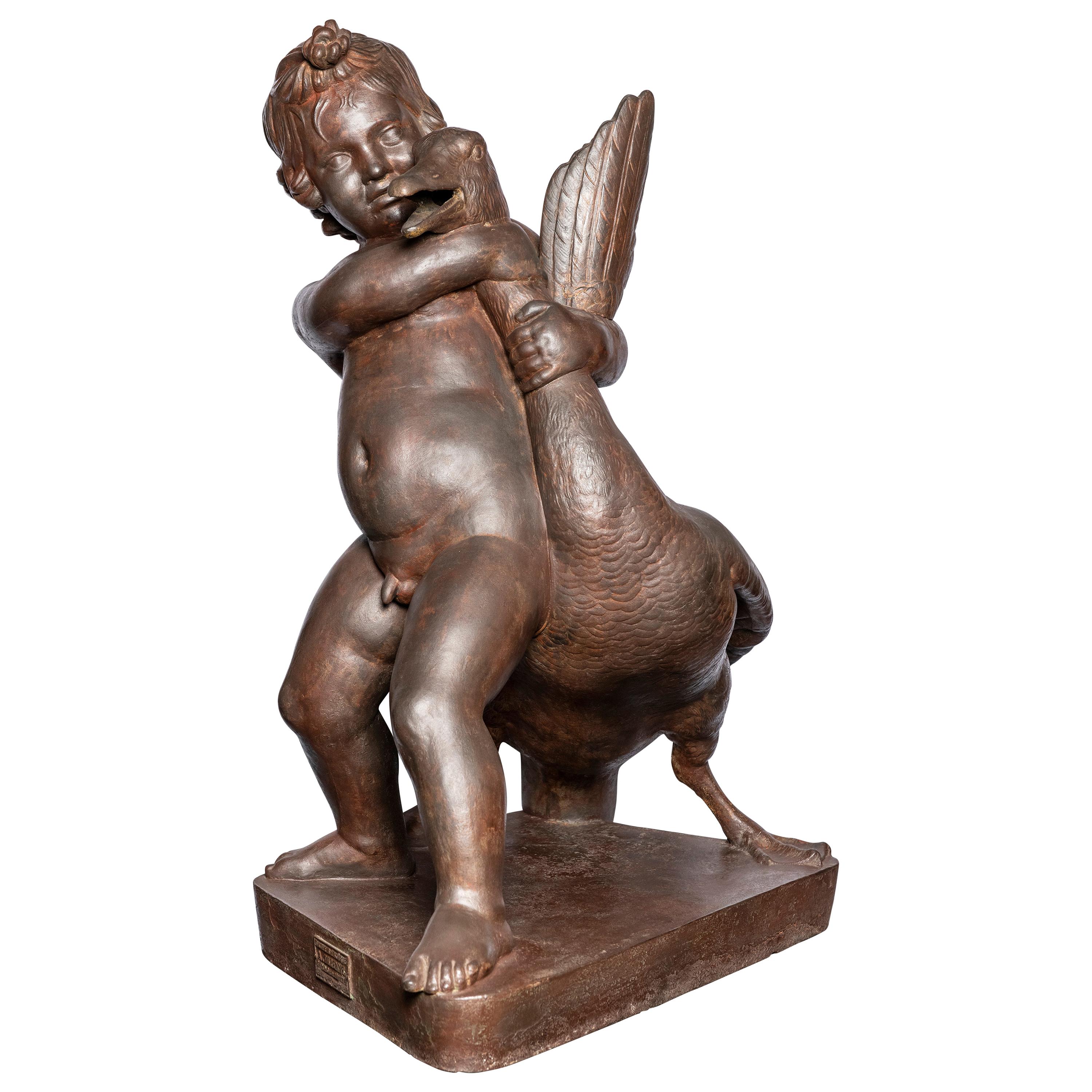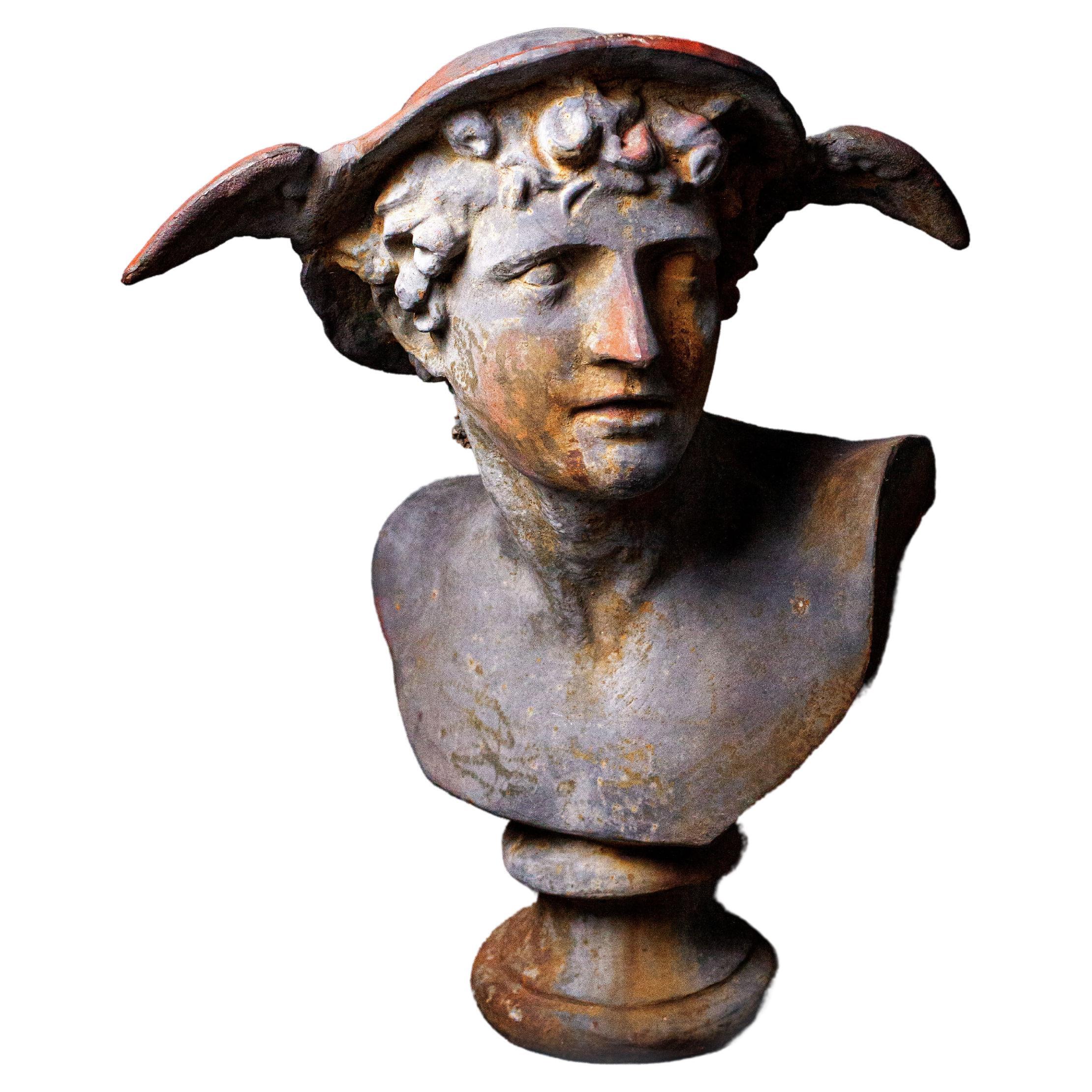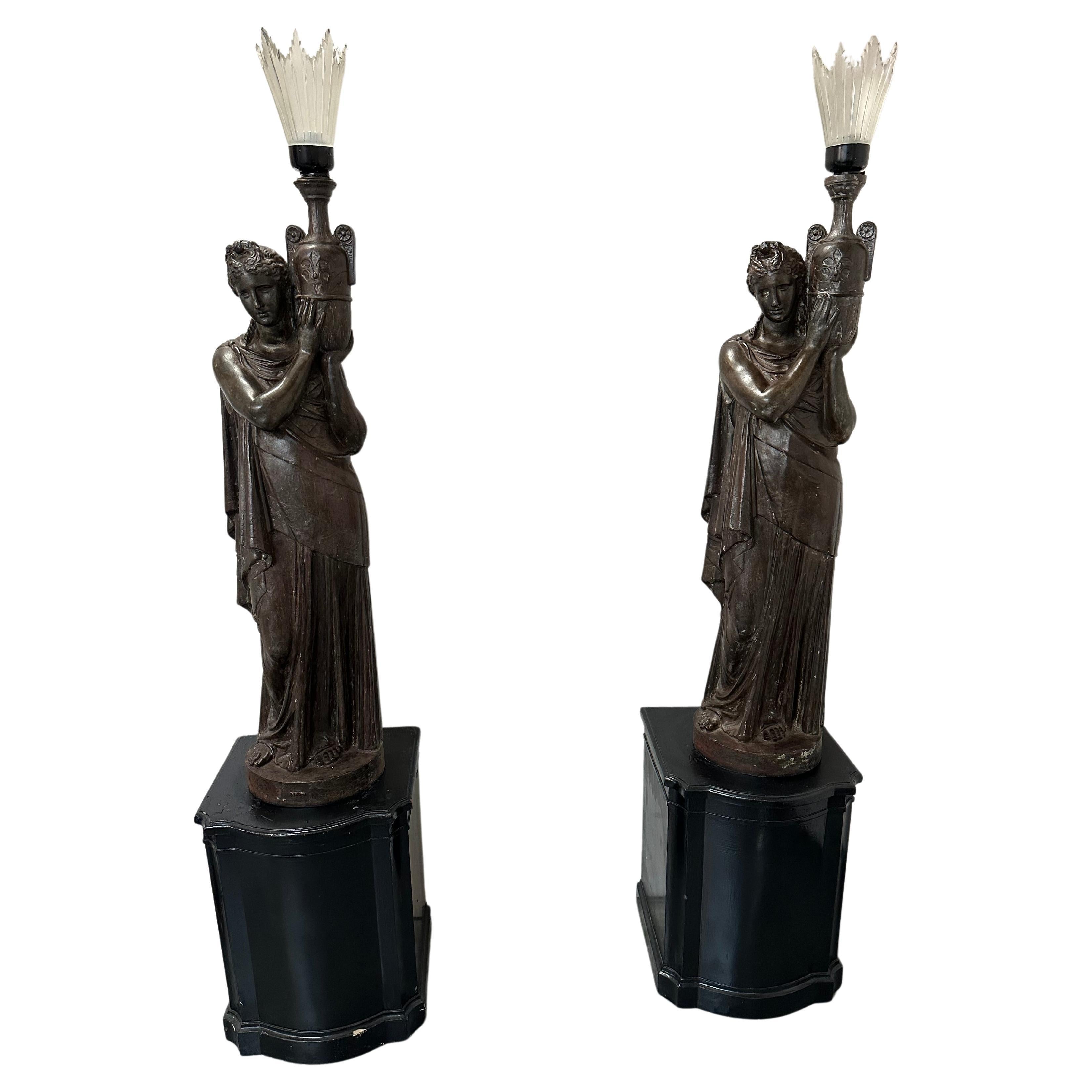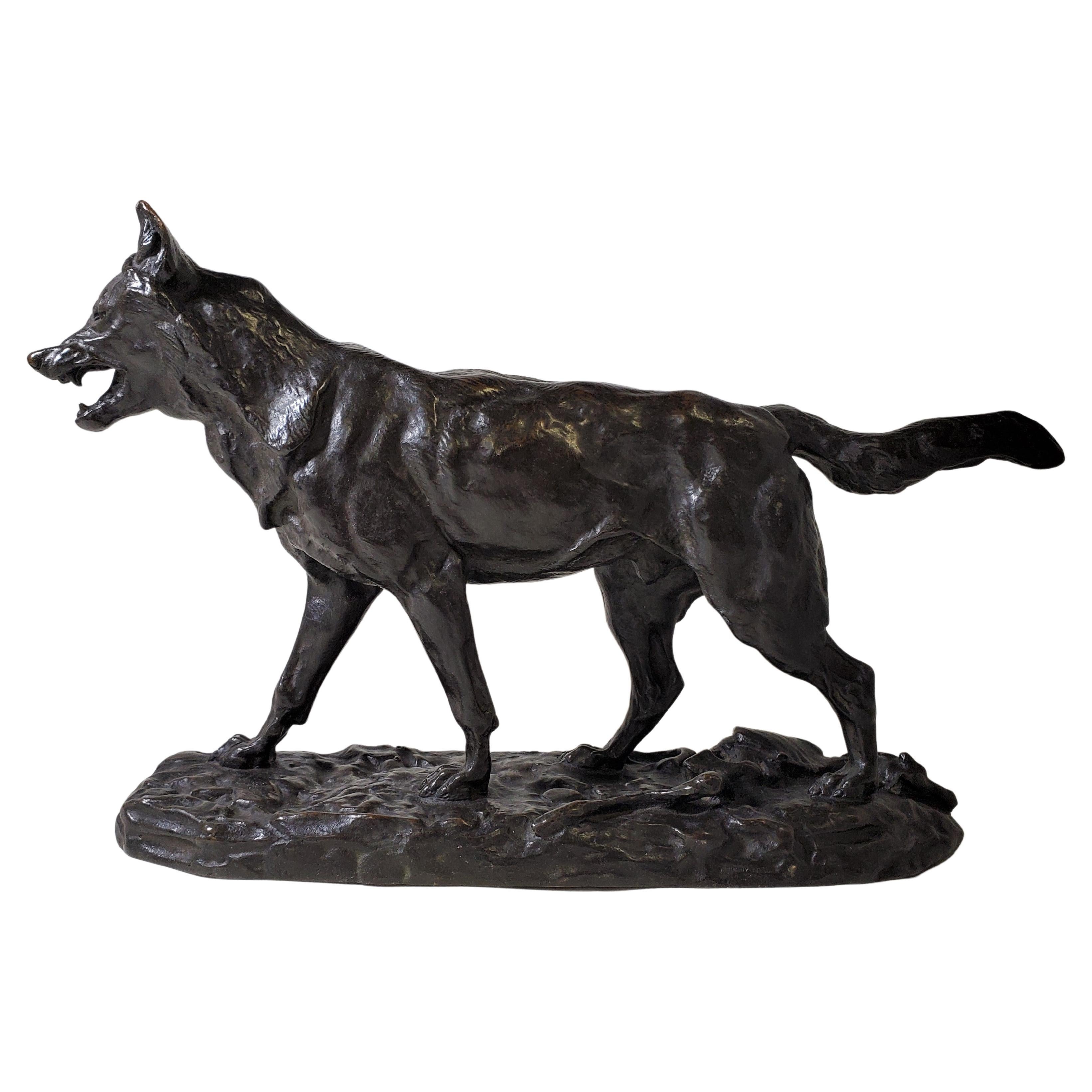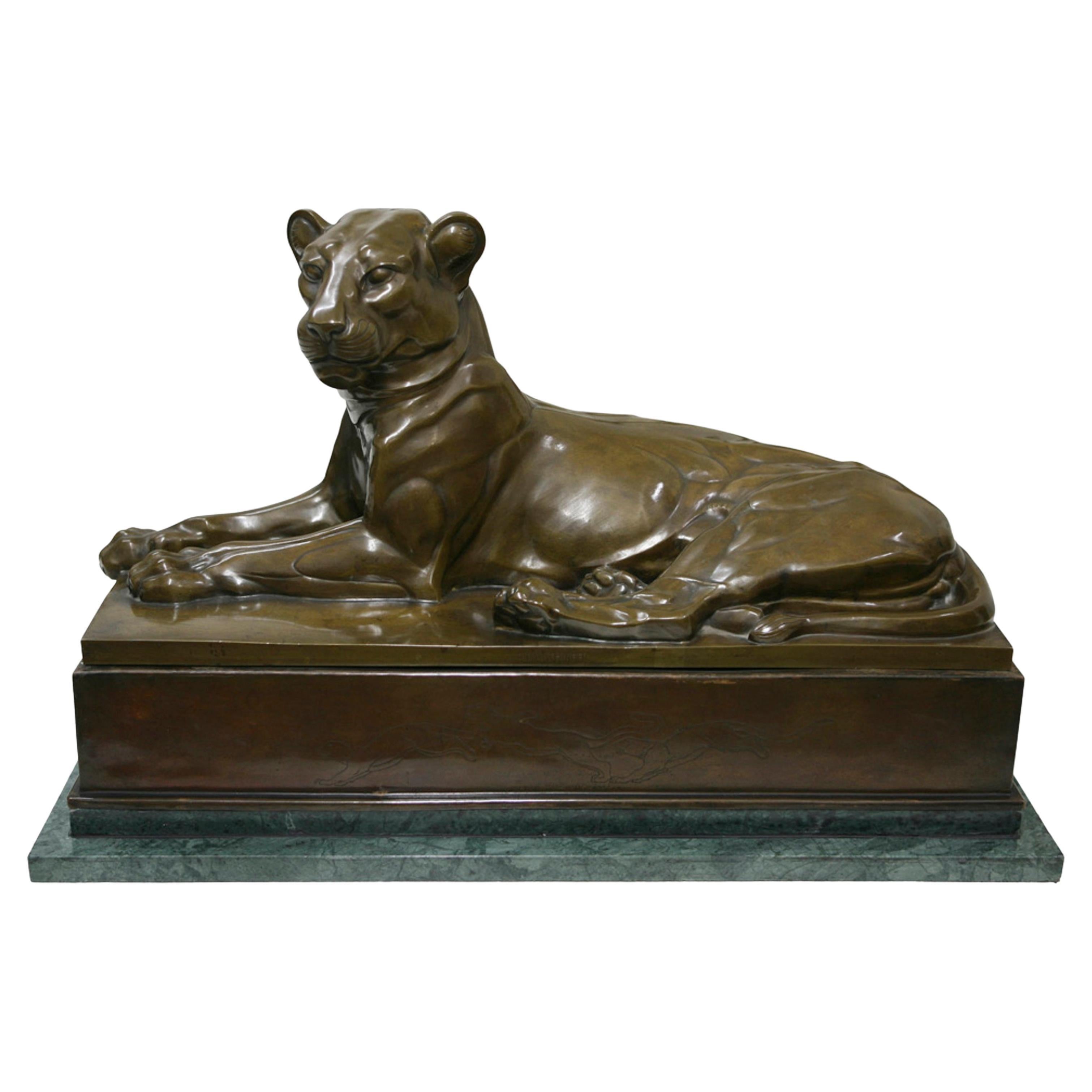Items Similar to Lyons by Antoine Durenne Was a French Cast Iron "Offer Free Shipping in Florida"
Video Loading
Want more images or videos?
Request additional images or videos from the seller
1 of 22
Lyons by Antoine Durenne Was a French Cast Iron "Offer Free Shipping in Florida"
About the Item
They are in Miami. We offer free shipping in Florida. They were exhibited at Palm beach "American International Fine Art Fair (AIFAF)"
In the photos you can see a pair of lions of the same signature as they are at the entrance of a palace in France "Château de Villers-Bocage"
A. Durenne
Antoine Durenne was a French cast iron and bronze foundry, active, especially in Paris, France, between 1847 and 1930 and noted especially for its ornamental ironwork and over-life size, iron, and bronze, cast animal sculpture groups, examples of which can be found in several UK historic parks and gardens. The Durenne firm was begun in 1847 when Antoine Durenne (born 1822, died 1895) purchased a small foundry near where he lived at Sommevoire, near the Val d'Osne works, Haute-Marne, France. In 1855 the first blast furnaces were installed. By the 1860s, numerous examples of bas-reliefs, fountains, statues and vases were being produced and the firm began exhibiting its wares at various exhibitions, for example the 1862 International Exhibition in Paris. By the 1870s the firm was also producing balconies, balustrades, fireplaces, lamp posts amongst its other castings. In 1888 the foundry acquired the address of S.A.d.F. du Val d'Osne, Paris, Rue du Faubourg Poissonniere, 26. It was listed on the Poissonniere from 1896 until 1911. At some point, prior to 1930, the foundry merged with another of similar size forming the Societe Anonyme des Establissements Metallurgiques A Durenne et du Val d'Osne. In 1969 it was bought out by the Societe Generale de Fonderie d'Hydraulique et de Mecanique (GHM) which today continues to produce works at Antoine Durenne's original Sommevoire foundry. Sources: Davis, John, Antique Garden Ornament (Woodbridge, Suffolk: Antique Collectors' Club, 1991) Further reading: Durenne, Antoine, Fonte de Fer. A Durenne, Maitre de Forges: Edition de 1877 (Serie F), illustrated catalogue (Paris, 1877).
Why are there so many antiques in Argentina?
In the 1880 – 1940 there was a grate wave of immigration encouraged by the periods of war that were taking place.
1st World War took place between 1914 and 1918
2nd World War took place between 1939 and 1945
The immigrants options were New York or Buenos Aires. Tickets were cheap and in Buenos Aires they were welcomed with open arms, as it was a country where everything was still to be done.
Argentina was the country of new opportunities, labour was needed and religious freedom was assured, in many cases the of the family travel first until they were settled and then the rest of the family members join them.
In the immigrant museum “Ellis Island Immigrant Building” in New York you can se the promotional posters of the boats that would take them to a new life.
Between the years 1895 and 1896, Argentina had the highest DGP (gross domestic product) per capita in the world according to the Maddison Historical Statistics index, this situation arose due to the large amount of food being exported to European countries, which were at war.
The Argentinean ships left the port of Buenos Aires with food, but they returned with furniture, clothes and construction elements, (it´s common to see this the old buildings of the historic neighbourhood of San Telmo, the beams with the inscription “Made in England)”, as well as many markets that were built in Buenos Aires, such us the San Telmo Market, whose structure was brought by ship and afterwards assembled in 900 Defensa Street.
With the great influence of European immigrants living in the country, the children of the upper classes travelled to study in France, resulting in the inauguration of “La Maison Argentinienne”, on 27th of June 1928, in the international city of Paris, which hosted many Argentinians that were studying in Frace.
It´s the fourth house to be built after France, Canada and Belgium, being the first Spanish-speaking one. Still in place today (17 Bd Jourdan, 75014, Paris, France). Many of the children of these wealthy families who attended international art exhibitions, museums and art courses abroad, took a keen interest in the European style. This is why Buenos Aires was at the time referred as “The Paris of South America”.
Between the years 1890 and 1920 more than a hundred Palaces were built on Alvear Avenue the most exclusive avenue in Buenos Aires. Today some of these palaces have been transformed into museums, hotels and embassies.
In the year 1936, the Kavanagh building was inaugurated, it was the tallest reinforced concrete building in South America.
During 1994 the American Society of Civil Engineers distinguished it as an “international engineering milestone”, and it´s now considered a World Heritage of Modern Architecture.
At the time was common to hire foreign architects such as Le Corbusier, who visited Buenos Aires/Argentina in 1929 and in 1948 he drew up the blueprints for a house built in La Plata City (which was declared a World Heritage Site).
In 1947, the Hungarian architect Marcelo Breuer designed “Parador Ariston” in the seaside city of Mar del Plata. After an Argentinean student at Harvard University convinced him to come to Argentina. He worked on an urban development project in the Casa Amarilla, area of La Boca.
The Ukrainian architect, Vladimiro Acosta, arrives in Argentina in 1928 and worked as an architect until que moved to Brazil.
Antonio Bonet, a Spanish architect who worked with Le Corbusier in Paris, arrives in Argentina in 1937, where he carried out several architectural works and in 1938 designs the well-known BFK chair.
Andres Kálnay, of Hungarian origin, made around 120 architectural masterpieces, among which the former Munich brewery stands out, he even made the furniture’s design.
The German architect, Walter Gropius, director of the Bauhaus, lived in Argentina, where he wrote articles for “Sur” magazine and founded in Buenos Aires, an architectural firm with Franz Möller, who was also an architect, where he built two houses.
At the same time several famous designers decided to immigrate to Argentina, among them we can find the well-known French designer, Jean-Michel Frank, who arrived in the country in 1940 and also worked for the Rockefeller family.
Special pieces were made, which were sold exclusively in the country, such as the well-known German company “WMF”, who sold their products by catalogue, which were chosen by the ladies of high society in the list of wedding gifts, as well as the pieces designed by Christofle.
The Swiss sculptor Alberto Giacometti, made special pieces for Argentinean mansions.
In 1904 the first Jansen branch outside Paris was established in Buenos Aires, as the Argentinean clientele demanded a large amount of furniture, from the end of the 19th century to the mid-20th century.
In 1970, the brand Rigolleau Argentina made pieces authorised by Lalique.
The brands Maple and Thompson also set up shop in the country.
The French plastic artist, Marcel Duchamp moved to Argentina in 1918-1919.
Glass signed Gallé, Charder, Leverre, Schneider, Muller and other French firms. They were bought in flower shops and were given to ladies with beautiful floral arrangements.
Some furniture manufacturers travelled to international fairs and bough the patterns to produce the furniture in Argentina, such as the furniture firm Englander and Bonta, who bought the patterns ins Italy.
It is worth mentioning that in Argentina we have the largest community of Italians outside of Italy, as it is estimated that 70 percent of the inhabitants have at least one Italian descendant, followed by Spanish immigrants.
The most Important furniture stores in Argentina:
Comte is founded in 1934 (under the direct management of Jean Michel Frank in 1940).
Nordiska (Swedish company established in 1934).
Churba in 1960, a company that brought foreign designers to present their furniture in the country:
Denmark: (Arne Jacobsen, Finn Juhl, Bender Madsen, Ejner Larsen, Poul Kjaerholm, Hans Wegner)
Sweden: (Hans Agne Jakobsson, Gustavsberg)
United States: (Herman Miller)
Finland: (Lisa Johansson, Folke Arstrom, Tapio Wirkkala, Alvar Aalto, Timo Sarpaneva)
Swedish Factory: (Orrefors)
Italy: (Littala, Vico Magistretti, Emma Gismondi, Gae Aulenti, Angelo Mangiarotti, Elio Martinelli, Gianna Celada, Angelo Mangiarotti, Mario Bellini, Carlo Scarpa)
Finland: (Olivia Toikka)
Plata Lappas (Lappas Silver): a goldsmith shop founded in 1887 in Argentina by Alcibiades Lappas of Greek origin.
In 2019, in Argentina took place “the Art Deco world congress”, in which we participated as hosts invited by Geo Darder, founder of the Copperbridge – Foundation, in which prominent people from all over the world attended to learn about Art Deco in Argentina.
Argentina currently has more than 100 Art Deco buildings and another 90 Art Nouveau buildings throughout the city of Buenos Aires.
Argentina is a country that has not been involved in many wars, which is why it has been a refuge for works of art and antiques from different periods of time, unlike European countries. That is way many collectors, museums and antique dealers from all over the world visit it, you should not miss the opportunity to visit this great country.
Laura Guevara Kjuder, architect.
- Creator:A. Durenne (Manufacturer)
- Dimensions:Height: 39.38 in (100 cm)Width: 15.75 in (40 cm)Depth: 31.5 in (80 cm)
- Sold As:Set of 2
- Style:Classical Roman (Of the Period)
- Materials and Techniques:
- Place of Origin:
- Period:
- Date of Manufacture:1889
- Condition:Wear consistent with age and use.
- Seller Location:Ciudad Autónoma Buenos Aires, AR
- Reference Number:
About the Seller
5.0
Vetted Seller
These experienced sellers undergo a comprehensive evaluation by our team of in-house experts.
Established in 1982
1stDibs seller since 2022
21 sales on 1stDibs
Typical response time: <1 hour
- ShippingRetrieving quote...Ships From: Hollywood, FL
- Return PolicyThis item cannot be returned.
More From This SellerView All
- 2 Sculptures of Women with Light by Val D'Osne 1889 " Free Shipping in Florida "By Val D'Osne FoundryLocated in Ciudad Autónoma Buenos Aires, C"Free shipping in florida" They were exhibited at Palm beach "American International Fine Art Fair (AIFAF)" The sculptures are Height: 136.5 cm (53.74 inch) Diameter: 28 cm ( 11.02 ...Category
Antique 1880s French Greco Roman Statues
MaterialsIron
- Art Deco Lyon by R. Pauschinger, German, Material: BronzeBy Rudolf PauschingerLocated in Ciudad Autónoma Buenos Aires, CArt deco sculpture in Bronze Rudolf Pauschinger Pauschinger (1882-1957) worked as a sculptor and medalist in Stuttgart; from 1910 he wa...Category
Vintage 1920s German Art Deco Animal Sculptures
MaterialsMarble, Bronze
- "Galata Morente" Sculpture in Bronze and Marble F. Barbedienne FonduerBy F. Barbedienne FoundryLocated in Ciudad Autónoma Buenos Aires, CWe have specialized in the sale of Art Deco and Art Nouveau and Vintage styles since 1982. If you have any questions we are at your disposal. Pushing the button that reads 'View All From Seller'. And you can see more objects to the style for sale. F. Barbedienne fonduer Ferdinand Barbedienne (6 August 1810 – 21 March 1892) was a French metalworker and manufacturer, who was well known as a bronze founder. The son of a small farmer from Calvados, he started his career as a dealer in wallpaper in Paris. In 1838 he went into partnership with Achille Collas (1795-1859), who had just invented a machine to create miniature bronze replicas of statues. Together they started a business selling miniatures of antique statues from museums all over Europe, thus democratising art and making it more accessible to households.[2] From 1843 they extended their scope by reproducing the work of living artists and also diversified by making enamelled household objects. With the outbreak of the Franco-Prussian war in 1870 the firm briefly had to switch to cannon founding owing to the shortage of metals but resumed business afterwards. Following Barbedienne's death in 1892, he was buried in the Père-Lachaise cemetery and the firm was carried on by his nephew Gustave Leblanc until 1952. Among the principal artists reproduced by the firm were Antoine Louis Barye and Auguste Rodin. The Dying Galata (Italian: Galata morente...Category
Antique 1870s French Classical Roman Figurative Sculptures
MaterialsBronze
- Child sculpture in Bronze and marbleLocated in Ciudad Autónoma Buenos Aires, CWe have specialized in the sale of Art Deco and Art Nouveau and Vintage styles since 1982.If you have any questions we are at your disposal. Pushing the button that reads 'View All F...Category
Vintage 1920s French Art Deco Figurative Sculptures
MaterialsMarble, Bronze
- Woman with Torch, France, Material: Bronze and Marble, Sign: BeerLocated in Ciudad Autónoma Buenos Aires, CJugendstil, Art Nouveau, Liberty sculpture in Bronze and marble. We have specialized in the sale of Art Deco and Art Nouveau and Vintage styles sinc...Category
Antique Early 1900s French Art Nouveau Figurative Sculptures
MaterialsMarble, Bronze
- 2 Crane Bird Material, Bronze and Marble Sign, Susse Freres, France, 1900By Susse FreresLocated in Ciudad Autónoma Buenos Aires, CSculpture in bronze We have specialized in the sale of Art Deco and Art Nouveau and Vintage styles since 1982. If you have any questions we are at your disposal. Pushing the button that reads 'View All From Seller'. And you can see more objects to the style for sale. Susse freres...Category
Antique Early 1900s French Art Nouveau Animal Sculptures
MaterialsBronze
You May Also Like
- Cast Iron Fountain Sculpture "Boy with Goose" Signed Antoine Durenne FonderieBy A. DurenneLocated in Buenos Aires, Buenos AiresCast iron fountain sculpture "Boethus Boy with goose" signed Antoine Durenne Fonderie, France, late 19th century. Green marble pedestal dimensions: 95 ...Category
Antique Late 19th Century French Neoclassical Figurative Sculptures
MaterialsIron
- Cast Iron Bust of NikeLocated in Bloomfield Hills, MIWe presents for your consideration, this cast-iron bust of Nike. A handsome decorative object for the garden, garden terrace, or interior space, Nike will add that layer of colle...Category
20th Century English Classical Roman Busts
MaterialsIron
- 19th Century French cast iron statue, stamped A. Durenne sommevoireLocated in Maidstone, GBA beautiful and very high quality French 19th century cast iron statue of a young boy dancing and skipping while playing the flutes, signed by the famous A. Durenne sommevoire. Excep...Category
Antique 19th Century French Statues
MaterialsIron
- Original French Bronze Sculpture of a Striding Wolf, by Antoine- Louis BaryeBy Antoine-Louis BaryeLocated in New York City, NYA fine original, French, early 20th century bronze statue of a walking wolf "Loup qui Marche" signed by Antoine-Louis Barye, Henry Bonnard foundry Co NY ...Category
Early 20th Century French Beaux Arts Animal Sculptures
MaterialsBronze
- Antique Salin French Neoclassical Cast Iron Garden Sculpture Statue Cherub 34"By Salin Foundry, ParisLocated in Dayton, OH19th century salin foundry French neoclassical cast iron sculpture statue, France Features two boys playing Front of plinth inscribed Salin, France Salin Foundry, Dammarie-sur-S...Category
Antique 19th Century Renaissance Figurative Sculptures
MaterialsIron
- Pair of Cast Iron Putti FiguresLocated in London, GBA charming pair of cast iron putti figures. Early to mid-20th century, great untouched patina.Category
Early 20th Century English Neoclassical Statues
MaterialsIron
Recently Viewed
View AllMore Ways To Browse
Larsen Forged
Juhl Reading Chair
Belgian Art Deco Club Chairs
Fer Forge Antique
Gae Aulenti Cast Iron Lamp
Pair Wegner F
Italian Bronze Iron Fireplace
Reading Chair Wegner
Antique French Cast Iron Garden Chairs
Pair Of Art Deco Club Chairs Belgium
Lisa Lyon
Art Deco Fireplace Grate
Fer Forge Chairs
1939s Fireplace
Finn Juhl Reading
Finn Juhl Reading Chair
Pair Swedish Bronze Chairs
Antique Cast Iron Lamp Stand
